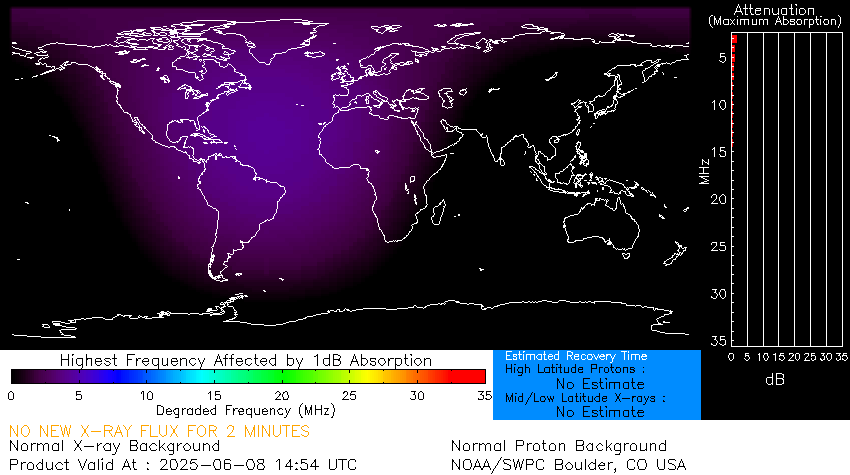
|
| The Southern Indiana Weather Spotter's Reference |
|
Serving the Tri-State with LIVE Radar & Weather Updates |

|
|
| |
Forecast: |
|
|
 FORECAST FOR THE EVANSVILLE, INDIANA AREA...... FORECAST FOR THE EVANSVILLE, INDIANA AREA......
|
|
|
|
|
| Amateur Radio HF Propagation |
 |
HF communications use the ionosphere
for long range skywave propagation. It consists of the
D, E, and F layers extending 50 to 600 miles around the earth
and is created by
radiation from the sun.
Each layer either refracts or absorbs signals depending on the level
of ionization and wavelength. The outermost F layer supports the majority of
long range (skywave) HF propagation while the innermost D layer primarily absorbs
160M, 80M and 40M signals during the day.
Ionization (during the day) and dissipation (during the night) is a daily process
impacting HF band performance.
The level of impact depends on
the season and the solar conditions including
the 11 year sunspot cycle.
|
| Current HF Band Conditions |
|
|
HF Band Propagation status
displays the current long range (skywave) performance expected
over the various HF amateur radio bands based on current
solar activity. Parameters such as the Smoothed Sunspot Number (SSN) and
Solar Flux Index (SFI) reflect the degree of ionizing
radiation available from the sun supporting effective ionospheric propagation.
|
| Solar Flares / Band Outages |
|
|
Solar Flares can disrupt HF radio
communications for minutes to hours.
The flares occur near sunspots and are outbursts of x-ray and extreme ultraviolet radiation.
|
| Geomagnetic Activity / HF Impact |
|
|
Geomagnetic activity can disturb the F-layer
of the ionosphere reducing the maximum useable HF frequency.
|
| D-Layer Absorption |
 |
|
D-layer absorption can occur during Solar Flares
as ionization takes place during the increased x-ray flux. The impact can be amazing - the HF bands can go dead in an instant
making you wonder your radio broke. The plot above shows the highest frequency impacted by a flare and the projected recovery time.
|
| Which Bands are Actually Working |
 |
The Weak Signal Propagation Reporting Network
(WSPR) is implemented via a
computer program and protocol that uses weak-signal radio communication
between amateur radio stations to identify potential propagation paths.
Thousands of stations worldwide, some receive only,
automatically upload their reception reports to a central database
called WSPRnet. A live map is provided showing the successful propagation
paths established by those stations giving an instant snapshot of band performance.
View the current world-wide status of operational
HF propagation paths at:
|
| HF Propagation Prediction Online Program |
 |
VOACAP Online for Ham Radio
is a very easy to use point-to-point HF propagtion prediction tool. You provide
your location, the point you want to communicate with, and (optionally) your antenna type, power level,
and mode of operation (i.e. SSB) and it does all the work for you!. Based on current solar
conditions, it provides you with the best 3 HF amateur bands to use, the expected received signal levels, and the
projected reliability of those communications paths. You also get a plot showing the time
of day those bands will work best for you. IT IS AS SIMPLE AS THAT!
|
| The Solar Sunspot Cycle Plot |
 |
Sunspot Cycle #25 is in progress
following Cycle 24, a noticeably weak one, during the latter half of 2020.
The last cycle had substantially fewer sunspots, solar flares, and coronal mass ejections
than others. Solar Cycle 25 had a slow start but is anticipated to peak with solar maximum
occurring between 2023 and 2026, during which we will hopefully enjoy
tremendous performance on the HF bands.
|
| The Latest Space Weather Forecast |
 |
The Space Weather Woman, Dr. Tamitha Skov
brings you the latest updates regarding space weather and the impact on HF
amateur radio propagation.
Stay up to date on the spectacular events the sun sends our way by watching the weekly videos
or reading the daily forecasts provided by Dr. Skov.
|
|
|



